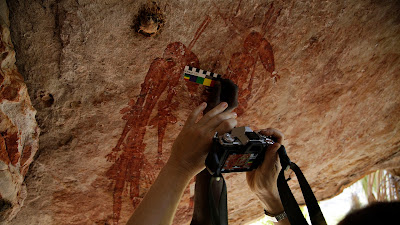
Australian mud wasp, Sceliphron laetum.
And while we have been on the subject of rock art in Australia - mud daubers (wasps) have long been a friend to potters as a guide to good deposits of local clays they can use to produce their pottery, now they are becoming recognized as friends to Australian rock art researchers as a source of potential dating for rock art panels.
Not so much a new technique, but a new source of datable material has been found in rock art panels in Australia - mud wasp nests. Made from mud found locally by "mud dauber" wasps, the nests are assembled with cells for the incubation of the offspring, then filled with stung and paralyzed insects for food and a single egg by the female wasp. A mud wasp nest on top of a painted rock art panel will have to have been made after the rock art was created, and if paint is found on top of the remains of an earlier mud wasp nest that nest is older than the painting. If there are a number of nests, and they can be dated, the oldest date from on top of the paint will establish a minimum age range for the rock art (this could be true for petroglyphs as well). A range of maximum and minimum dates can be determined if there are nests found both over and under the painted image. If found in a protected location such as a rock shelter, a mud wasp nest can last a very long time indeed.
How can a mud wasp nest provide dating you ask? There are currently two possibilities; AMS 14C dating, and optically-stimulated luminescence (OSL). For AMS 14C dating small bits of organic matter in the dried mud are extracted and dated with an accelerator mass spectrometer (AMS), and the OSL dating is done on small grains of quartz sand included in the dried mud.
"OSL is a light sensitive signal that builds up over time during a period of 'burial' or cover. Provided the samples are not exposed to light during collection the signal can be stimulated in laboratory conditions and measured. When divided by the natural radioactivity of the soil or substrate, the amount of light (luminescence) produced is proportional to the period of burial time. OSL is the main method used for establishing chronologies for excavated occupation deposits that pre-date the maximum AMS 14C boundary, or in deposits that lack ample carbon samples. Samples of sediments found within the cave environment have no direct association with the art, but sediments may be collected by wasps and then 'buried' within mudwasp nests found on top of the art. Dating of mudwasp nests using OSL was first introduced by Roberts et al. They initially worked with large nests and sampled each layer to determine the extent to which light no longer penetrated the nests and the quartz was effectively 'buried' and supported their OSL age estimates with AMS 14C or organics found within two nests (Roberts et al)".
As mud dauber wasps are found pretty much all over the world this tool may provide valuable information in many instances where rock art is otherwise undatable.
NOTE: Some images in this posting were retrieved from the internet with a search for public domain photographs. If any of these images are not intended to be public domain, I apologize, and will happily provide the picture credits if the owner will contact me with them. For further information on these reports you should read the original reports at the sites listed below.
REFERENCES:
Roberts
RG, Walsh GL, Murray A, Olley J, Jones R, Morwood MJ, et al.
1997 Luminescence
dating of rock art and past environments using mud-wasp nests in northern
Australia, Nature, 1997; 387 (6634): 696-699.
Ross, June, Kira Westaway, Meg Travers, Michael J. Morwood, and John Hayward,
2016 Into the
Past: A Step Towards a Robust Kimberley Rock Art Chronology, August 31,
2016, Plosone,
https://journals.plos.org/plosone/article?id=10.1371/journal.pone.0161726






No comments:
Post a Comment